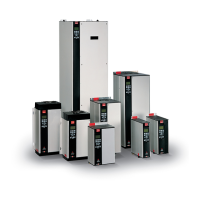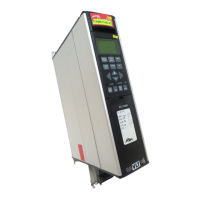4-1
VLT is a registered Danfoss trademark
Torque Limit, Current Limit, and Unstable
Motor Operation
Excessive loading of the drive may result in warning or tripping
on torque limit, over current, or inverter time. This is not a
concern if the drive is properly sized for the application and
intermittent load conditions cause anticipated operation in
torque limit or an occasional trip. However, nuisance or
unexplained occurrences may be the result of improperly setting
specific parameters. The following parameters are important
in matching the drive to the motor for optimum operation.
These setting need careful attention, particularly for the
selectable torque drives of the VLT 5000 series. For the VLT
4000/6000/8000 series, torque settings are constant.
Parameters 100 and 101 set the mode in which the drive
will operate.
Parameters 102 through 107 match the drive to the motor
and adapt to the motor characteristics.
Parameters 221 and 409 set the torque control features
of the drive for the application.
Parameter 100, Configuration, sets the drive for open or closed
loop operation or torque mode operation. In a closed loop
configuration, a feedback signal controls the drive speed. The
settings for the PID controller play a key role for stable operation
in closed loop, as described in the operator's manual. In open
loop, the drive calculates the torque requirement based on
current measurements of the motor.
Parameter 101, Torque Characteristics, for the VLT 5000 series,
sets the drive for constant or variable torque operation. It is
imperative that the correct torque characteristic is selected,
based on the application. If, for example, the load type is
constant torque, such as a conveyor, and variable torque is
selected, the drive may have great difficulty starting the load,
if started at all. Consult the factory if uncertain about the torque
characteristics of an application.
Parameters 102 through 106 configure the drive for the
connected motor. These are motor power, voltage, frequency,
current, and rated motor speed. Accurate setting of these
parameters is very important. Enter the motor data required
as listed on the motor nameplate. For effective and efficient
load control, the drive relies on this information for calculating
the output waveform in response to the changing demands of
the application.
Parameter 107 activates the automatic motor adaptation (AMA)
function. When AMA is performed, the drive measures the
electrical characteristics of the motor and sets various drive
parameters based on the findings. Two key parameter values
set by this function are stator resistance and stator reactance,
parameters 108 and 109. If unstable motor operation is
experienced and AMA has not been performed, it should be
done. AMA can only be performed on single motor applications
within the programming range of the drive. Consult the
instruction manual for more on this function.
Parameters 108 and 109, as stated, should be set by the
AMA function, values supplied by the motor manufacturer, or
left at the factory default values. Never adjust these parameters
to random values even though it may seem to improve
operation. Such adjustments can result in unpredictable
operation under changing conditions.
Parameter 221, Torque Limit, sets the limit for drive torque.
The factory setting is 160% for VLT 5000 series and 110% for
VLT 4000/6000/8000 series and will vary with motor power
setting. For example, a drive programmed to operate a smaller
rated motor will yield a higher torque limit value than the same
drive programmed to operate a larger size motor. It is important
that this value not be set too low for the requirements of the
application. In some cases, it may be desirable to have a
torque limit set at a lesser value. This offers protection for the
application in that the drive will limit the torque. It may, however,
require higher torque at initial start up. Under these
circumstances, nuisance tripping may occur.
Parameter 409, Trip Delay Torque, works in conjunction with
torque limit in the VLT 5000 series. This parameter selects the
length of time the drive operates in torque limit prior to a trip.
The factory default value is off. This means that the drive will
not trip on torque limit, but it does not mean it will never trip
from an overload condition. Built into the drive is an internal
inverter thermal protection circuit. This circuit monitors the
output load on the inverter. If the load exceeds 100% of the
continuous rating of the drive, a timer is activated. If the load
remains excessive long enough, the drive will trip on inverter
time. Adjustments cannot be made to alter this circuit.
Improper parameter settings effecting load current can result
in premature trips of this type. The timer can be displayed.
SECTION 4
DRIVE AND MOTOR APPLICATIONS
